Behavior of Piston Wind Induced by Braking Train in a Tunnel
Abstract
1. Introduction
2. Theoretical Model
2.1. Assumptions
- (1)
- Entering tunnel: the train travels into the tunnel; its velocity is unchanged.
- (2)
- Uniform motion: the whole train is traveling in the tunnel; its velocity is unchanged.
- (3)
- Uniformly decelerated motion: the train decelerates in the tunnel at a constant deceleration.
- (4)
- Stationary: the piston wind decays gradually after the train stops.
- (1)
- The piston wind in the tunnel is considered a one-dimensional unsteady airflow. As the Mach number of the piston wind is less than 0.3, it can be considered an incompressible flow [36].
- (2)
- The cross-passage doors are closed.
- (3)
- The variation of the cross-section area of the main tunnel is ignored.
- (4)
- The natural wind is ignored, i.e., the initial wind velocity in the tunnel is zero.
- (5)
- In the decelerated motion phase, the deceleration of the train is constant.
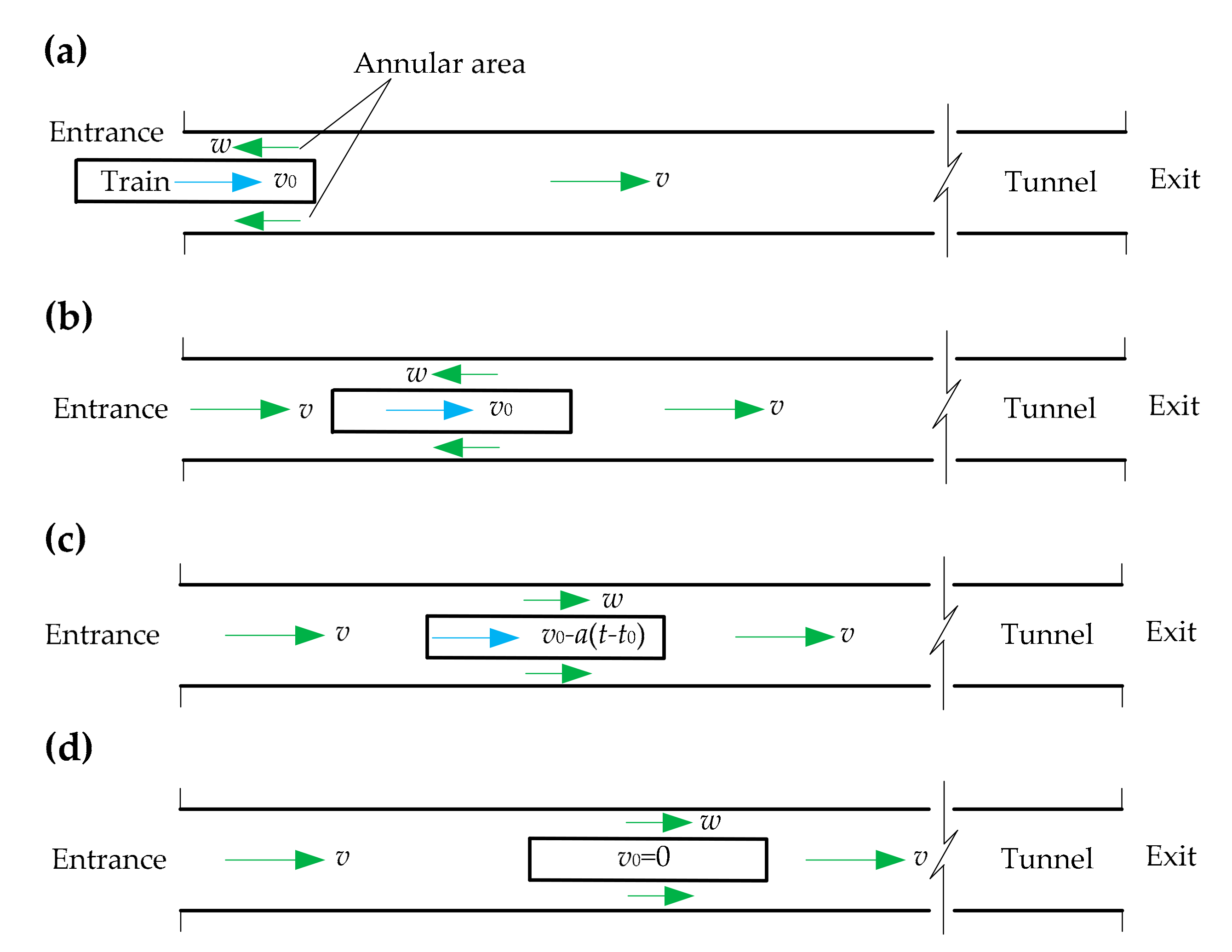
2.2. Basic Equations
2.2.1. Bernoulli’s Principle
2.2.2. Continuity Equation
2.3. Theoretical Derivation for Piston Wind
2.3.1. Entering Tunnel Phase
2.3.2. Uniform Motion Phase
2.3.3. Uniformly Decelerated Motion Phase
The Prophase of Uniformly Decelerated Motion
The Late Phase of Uniformly Decelerated Motion
2.3.4. Stationary Phase
3. Experiment Verification
3.1. Experiment Configuration
3.1.1. Similarity Scale
3.1.2. Experimental Apparatus
3.1.3. Layout of Test Cross-Sections
3.1.4. Test Conditions
3.2. Results
- (1)
- The results concluded by prediction formulas may have some errors because the formulas are based on some reasonable assumptions.
- (2)
- Because the Reynolds similarity cannot be realized, the frictional loss coefficient in the model tunnel is larger than its theoretical value. This results in a certain deviation between the test results in the model tunnel and the piston wind in an actual tunnel.
- (3)
- The geometric scale is 1/50 and the velocity ratio is 1/8.33, resulting in a small random error that will be significantly amplified in the converted test results.
- (4)
- Errors are caused by the test instruments.
- (5)
- There are 14 transducers to collect wind velocity data in the non-train space, and the delay from synchronization of the transducers may also be amplified in the converted test results.
4. Discussion
- (1)
- The longer the tunnel, the weaker the piston wind due to the larger frictional loss. The length of time the piston wind velocity is at its peak is longer as the tunnel is longer because the time of the train’s uniform motion is longer. The longer the tunnel, the faster the piston wind decays.
- (2)
- The longer the train’s length, the stronger the piston wind owing to the smaller train resistance. The length of time the piston wind velocity is at its peak changes slightly with increasing length of the train because the time of the train’s uniform motion changes little. The decay time of the piston wind is nearly the same for each of the six different lengths of the train.
- (3)
- The faster the train, the stronger the piston wind owing to the greater momentum transferred to the air from the train. The length of time the piston wind velocity is at its peak is longer as the train’s velocity is faster because the time of the train’s uniform motion is shorter. The faster the train, the more slowly the piston wind decays.
- (4)
- The larger the blockage ratio, the stronger the piston wind owing to the greater momentum transferred to the air from the train. The length of time the piston wind velocity is at its peak is slightly longer because the hindering effect of the train on the air is slightly enhanced. The decay time of the piston wind is nearly the same for each of the seven kinds of blockage ratios.
5. Conclusions
- (1)
- The theoretical formulas in this paper can accurately predict piston the wind behavior induced by a braking train in a railway tunnel. The theoretical formulas are suitable for similar train running conditions in super-long railway tunnels or subway tunnels.
- (2)
- Piston wind increases continuously in the entering tunnel phase and the uniform motion phase, decreases continuously in the decelerated motion phase, and decays gradually to zero after the train stops. It reaches the peak value as the train begins to decelerate.
- (3)
- The wind direction in the annular area varies in different train running phases. The wind flows relatively to the train’s rear before the time the train velocity equals the piston wind velocity, and it flows relative to the train’s head after that time.
- (4)
- Piston wind was significantly influenced by tunnel length, train length, train velocity and blockage ratio. Tunnel length and train velocity significantly affected the duration time of peak piston wind velocity, while train length and blockage ratio slightly affected the duration time.
Author Contributions
Funding
Conflicts of Interest
Nomenclature
| Air pressure [Pa]. | |
| Air density [kg/m3]. | |
| Gravity acceleration [m/s−2]. | |
| Gravity acceleration [m/s−2]. | |
| Local loss coefficient. | |
| Frictional loss coefficient. | |
| Train drag coefficient. | |
| Impact factor of piston wind. | |
| Train velocity [m/s]. | |
| Piston wind velocity [m/s]. | |
| Wind velocity in the annular area [m/s]. | |
| Relative velocity of wind in the annular area [m/s]. | |
| Rate of deceleration for the train [m/s2]. | |
| Blockage ratio. | |
| Scale. | |
| Length [m]. | |
| Equivalent diameter [m]. | |
| Time [s]. | |
| Viscosity coefficient of fluid. | |
| Cross-sectional area [m2]. |
References
- Zhang, H.; Zhu, C.; Zheng, W.; You, S.; Ye, T.; Xue, P. Experimental and numerical investigation of braking energy on thermal environment of underground subway station in China’s northern severe cold regions. Energy 2016, 116, 880–893. [Google Scholar] [CrossRef]
- Zhang, H.; Cui, T.; Liu, M.; Zheng, W.; Zhu, C.; You, S.; Zhang, Y. Energy performance investigation of an innovative environmental control system in subway station. Build. Environ. 2017, 126, 68–81. [Google Scholar] [CrossRef]
- Zhou, X.; Zeng, Y.; Fan, L. Temperature field analysis of a cold-region railway tunnel considering mechanical and train-induced ventilation effects. Appl. Therm. Eng. 2016, 100, 114–124. [Google Scholar] [CrossRef]
- Zhong, W.; Tu, R.; Yang, J.P.; Liang, T.S. A study of the fire smoke propagation in subway station under the effect of piston wind. J. Civ. Eng. Manag. 2015, 21, 514–523. [Google Scholar] [CrossRef]
- Tong, Y.; Wang, X.; Zhai, J.; Niu, X.; Liu, L. Theoretical predictions and field measurements for potential natural ventilation in urban vehicular tunnels with roof openings. Build. Environ. 2014, 82, 450–458. [Google Scholar] [CrossRef]
- Wang, Z.; Tao, H.; Du, X.; Dai, R.; Huang, C. Theoretical modeling of the platform piston wind wall jet using field measurements and model testing. Tunn. Undergr. Space Technol. 2015, 45, 1–9. [Google Scholar] [CrossRef]
- Zhang, H.; Zhu, C.; Liu, M.; Zheng, W.; You, S.; Li, B.; Xue, P. Mathematical modeling and sensitive analysis of the train-induced unsteady airflow in subway tunnel. J. Wind Eng. Ind. Aerodyn. 2017, 171, 67–78. [Google Scholar] [CrossRef]
- Juraeva, M.; Lee, J.-H.; Song, D.-J. A computational analysis of the train-wind to identify the best position for the air-curtain installation. J. Wind Eng. Ind. Aerodyn. 2011, 99, 554–559. [Google Scholar] [CrossRef]
- Lanchava, O.; Ilias, N.; Nozadze, G.; Radu, S.; Moraru, R.; Khokerashvili, Z.; Arudashvili, N. Modelling the piston effect in subway tunnels using fire dynamics simulator. Environ. Eng. Manag. J. 2019, 18, 865–872. [Google Scholar] [CrossRef]
- Fujii, K.; Ogawa, T. Aerodynamics of high speed trains passing by each other. Comput. Fluids 1995, 24, 897–908. [Google Scholar] [CrossRef]
- Kim, J.-Y.; Kim, K.-Y. Effects of vent shaft location on the ventilation performance in a subway tunnel. J. Wind Eng. Ind. Aerodyn. 2009, 97, 174–179. [Google Scholar] [CrossRef]
- Shin, C.-H.; Park, W.-G. Numerical study of flow characteristics of the high speed train entering into a tunnel. Mech. Res. Commun. 2003, 30, 287–296. [Google Scholar] [CrossRef]
- Huang, Y.-D.; Gong, X.-L.; Peng, Y.-J.; Lin, X.-Y.; Kim, C.-N. Effects of the ventilation duct arrangement and duct geometry on ventilation performance in a subway tunnel. Tunn. Undergr. Space Technol. 2011, 26, 725–733. [Google Scholar] [CrossRef]
- Huang, Y.; Gong, X.-L.; Peng, Y.-J.; Kim, C.N. Effects of the solid curtains on natural ventilation performance in a subway tunnel. Tunn. Undergr. Space Technol. 2013, 38, 526–533. [Google Scholar] [CrossRef]
- Izadi, T.; Mehrabian, M.A.; Abouali, O.; Ahmadi, G. 3-D numerical analysis of train-induced flow inside four ventilated underground subway stations and connecting tunnels. J. Wind Eng. Ind. Aerodyn. 2019, 193, 103974. [Google Scholar] [CrossRef]
- Wang, F.; Wang, M.; Wang, Q.; Zhao, D. An improved model of traffic force based on CFD in a curved tunnel. Tunn. Undergr. Space Technol. 2014, 41, 120–126. [Google Scholar] [CrossRef]
- Khaleghi, M.; Talaee, M.R. Analysis of unsteady airflow in a subway station influenced by train movement. Sci. Technol. Built Environ. 2020, 26, 210–218. [Google Scholar] [CrossRef]
- Liu, M.; Zhu, C.; Cui, T.; Zhang, H.; Zheng, W.; You, S. An alternative algorithm of tunnel piston effect by replacing three-dimensional model with two-dimensional model. Build. Environ. 2018, 128, 55–67. [Google Scholar] [CrossRef]
- González, M.L.; Vega, M.G.; Oro, J.M.F.; Marigorta, E.B. Numerical modeling of the piston effect in longitudinal ventilation systems for subway tunnels. Tunn. Undergr. Space Technol. 2014, 40, 22–37. [Google Scholar] [CrossRef]
- Yang, Z.; Su, X.; Ma, F.; Yu, L.; Wang, H. An innovative environmental control system of subway. J. Wind Eng. Ind. Aerodyn. 2015, 147, 120–131. [Google Scholar] [CrossRef]
- Zarnaghsh, A.; Abouali, O.; Emdad, H.; Ahmadi, G. A numerical study of the train-induced unsteady airflow in a tunnel and its effects on the performance of jet fans. J. Wind Eng. Ind. Aerodyn. 2019, 187, 1–14. [Google Scholar] [CrossRef]
- Cross, D.; Hughes, B.; Ingham, D.; Ma, L. A validated numerical investigation of the effects of high blockage ratio and train and tunnel length upon underground railway aerodynamics. J. Wind Eng. Ind. Aerodyn. 2015, 146, 195–206. [Google Scholar] [CrossRef]
- Cross, D.; Hughes, B.; Ingham, D.; Ma, L. Enhancing the piston effect in underground railway tunnels. Tunn. Undergr. Space Technol. 2017, 61, 71–81. [Google Scholar] [CrossRef]
- Zhang, N.; Lu, Z.; Zhou, D. Influence of train speed and blockage ratio on the smoke characteristics in a subway tunnel. Tunn. Undergr. Space Technol. 2018, 74, 33–40. [Google Scholar] [CrossRef]
- Liu, X.; Han, Y.; Li, D.; Tu, Y.; Deng, Z.; Yu, C.; Wu, X. Anti-pull mechanisms and weak interlayer parameter sensitivity analysis of tunnel-type anchorages in soft rock with underlying weak interlayers. Eng. Geol. 2019, 253, 123–136. [Google Scholar] [CrossRef]
- Zeng, Y.; Liu, K.; Zhou, X.; Fan, L. Tunnel temperature fields analysis under the couple effect of convection-conduction in cold regions. Appl. Therm. Eng. 2017, 120, 378–392. [Google Scholar] [CrossRef]
- Chen, T.Y.; Lee, Y.T.; Hsu, C.C. Investigations of piston-effect and jet fan-effect in model vehicle tunnels. J. Wind Eng. Ind. Aerodyn. 1998, 73, 99–110. [Google Scholar] [CrossRef]
- Kim, J.Y.; Kim, K.Y. Experimental and numerical analyses of train-induced unsteady tunnel flow in subway. Tunn. Undergr. Space Technol. 2007, 22, 166–172. [Google Scholar] [CrossRef]
- Gilbert, T.; Baker, C.J.; Quinn, A. Gusts caused by high-speed trains in confined spaces and tunnels. J. Wind Eng. Ind. Aerodyn. 2013, 121, 39–48. [Google Scholar] [CrossRef]
- Xue, P.; You, S.; Chao, J.; Ye, T. Numerical investigation of unsteady airflow in subway influenced by piston effect based on dynamic mesh. Tunn. Undergr. Space Technol. 2014, 40, 174–181. [Google Scholar] [CrossRef]
- Ma, J.; Zhang, X.; Li, A.; Deng, B.; Lv, W.; Guo, Y.; Zhang, W.; Huang, L. Analyses of the improvement of subway station thermal environment in northern severe cold regions. Build. Environ. 2018, 143, 579–590. [Google Scholar] [CrossRef]
- Liu, M.; Zhu, C.; Zhang, H.; Zheng, W.; You, S.; Campana, P.E.; Yan, J. The environment and energy consumption of a subway tunnel by the influence of piston wind. Appl. Energy 2019, 246, 11–23. [Google Scholar] [CrossRef]
- Krasyuk, A.M.; Lugin, I.V.; Pavlov, S.A. Experimental research into air distribution in a terminal subway station. Tunn. Undergr. Space Technol. 2019, 85, 21–28. [Google Scholar] [CrossRef]
- Zeng, Y.; Bai, Y.; Zhou, X.; Ruan, L. Numerical simulation analysis of piston wind change during train stopping at rescue station in railway tunnel. China Railw. Sci. 2016, 37, 128–133. (In Chinese) [Google Scholar]
- Bai, Y.; Zeng, Y.; Zhang, X.; Yan, X.; Ruan, L.; Zhou, X. Numerical and experimental study on the flow field induced by a train urgently speeding to the rescue station. Tunn. Undergr. Space Technol. 2016, 58, 74–81. [Google Scholar] [CrossRef]
- Zhou, G. Fluid Mechanics; Higher Education Press: Beijing, China, 1992. [Google Scholar]
- Ministry of Railways of the People’s Republic of China. Code for design on operating ventilation of railway tunnel. In TB10068-2010; China Railway Press: Beijing, China, 2010. [Google Scholar]
- Luo, Z.; Han, G.; Zhao, K.; Huang, S. Piston wind speed calculation method and analysis of influence factors for subway tunnel. J. Northeast. Univ. Nat. Sci. 2019, 40, 694–699. (In Chinese) [Google Scholar]


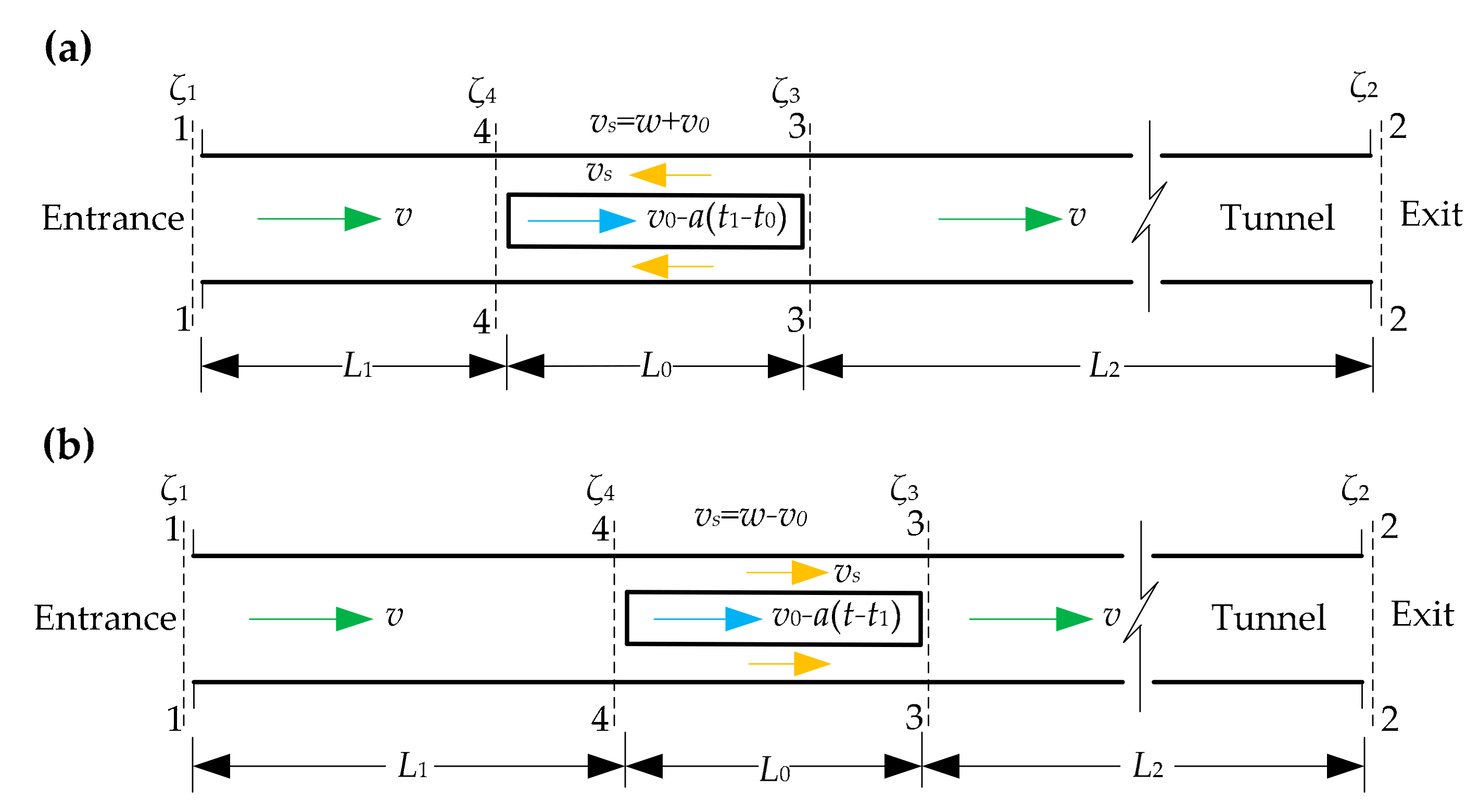

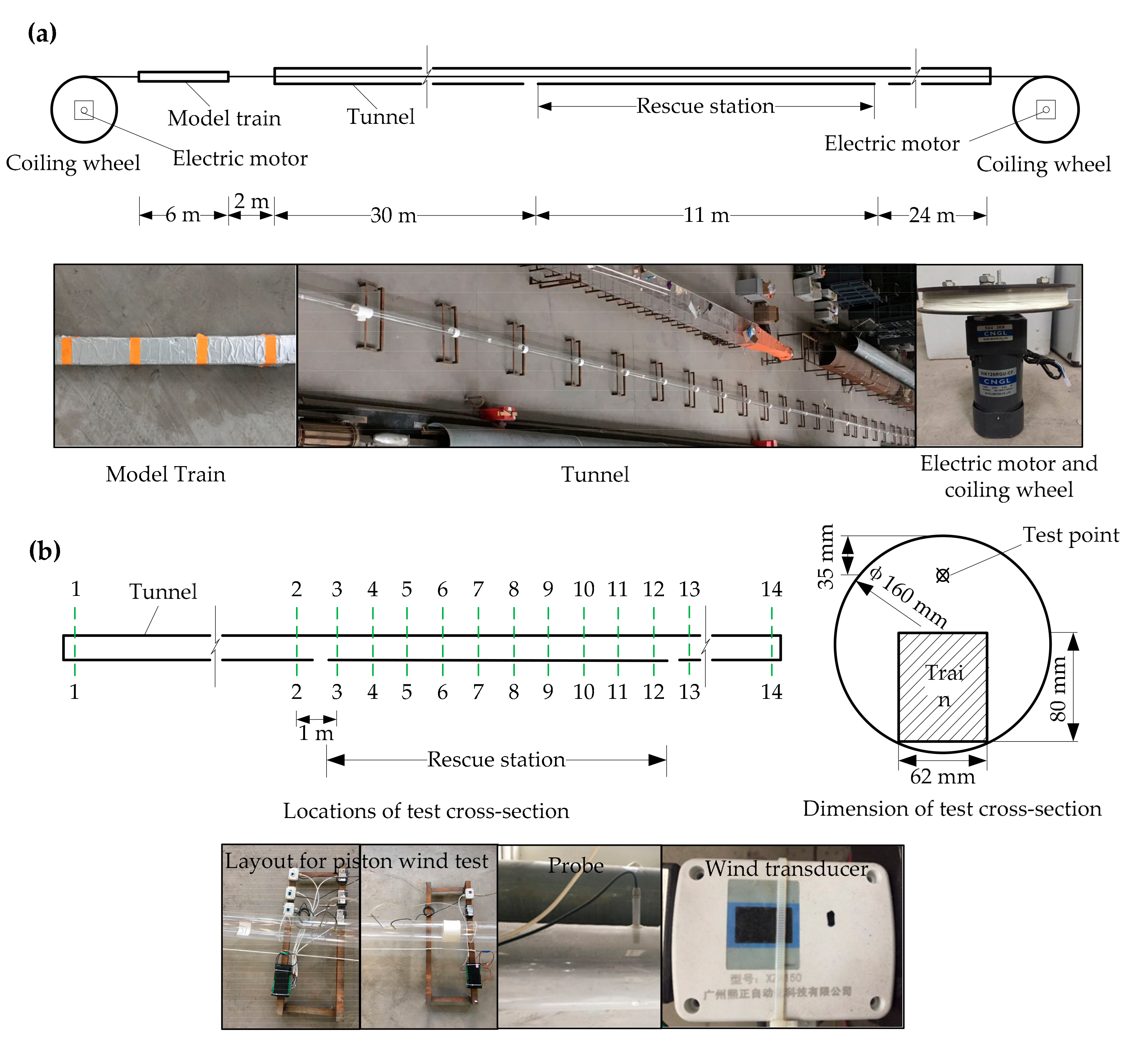
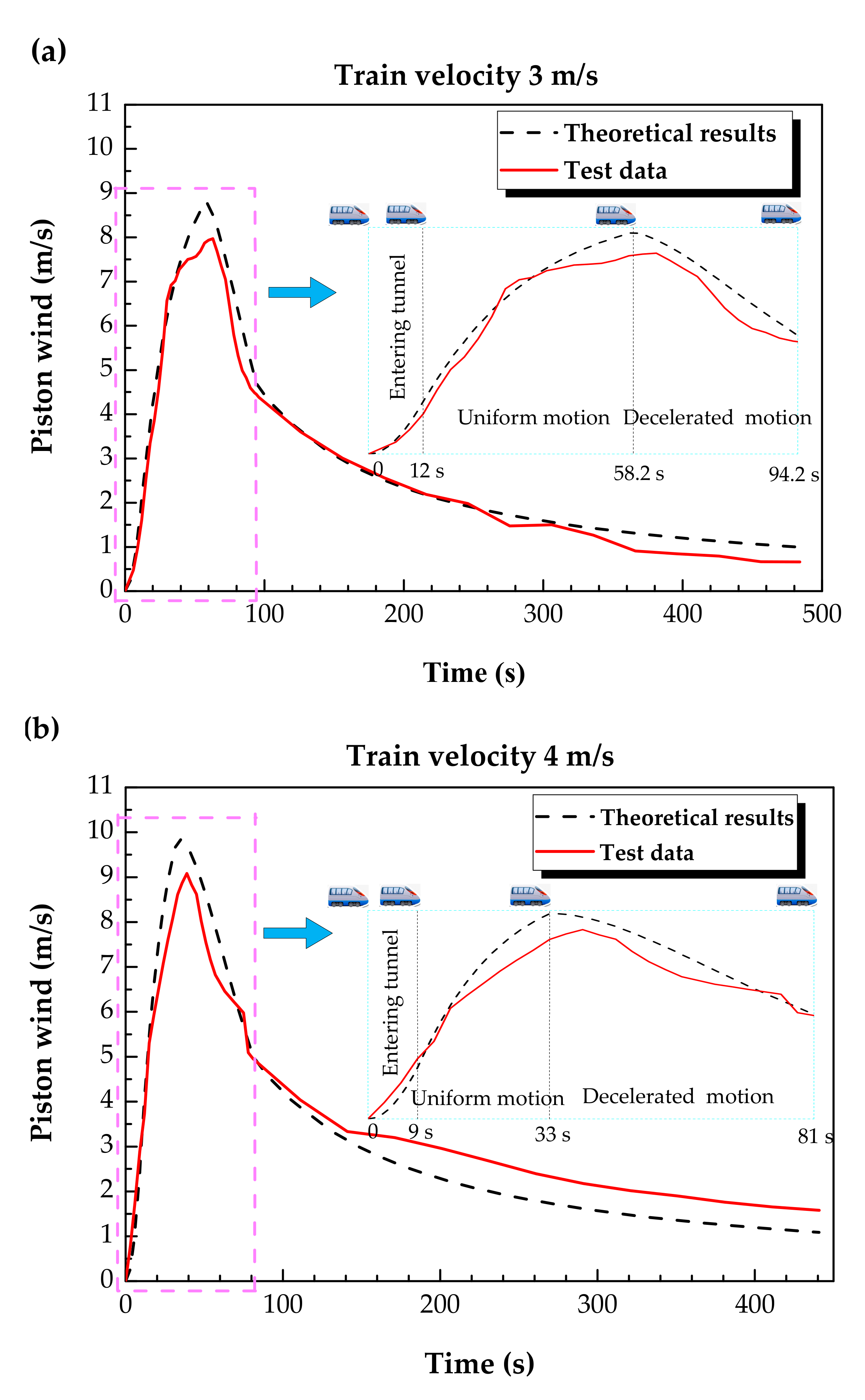


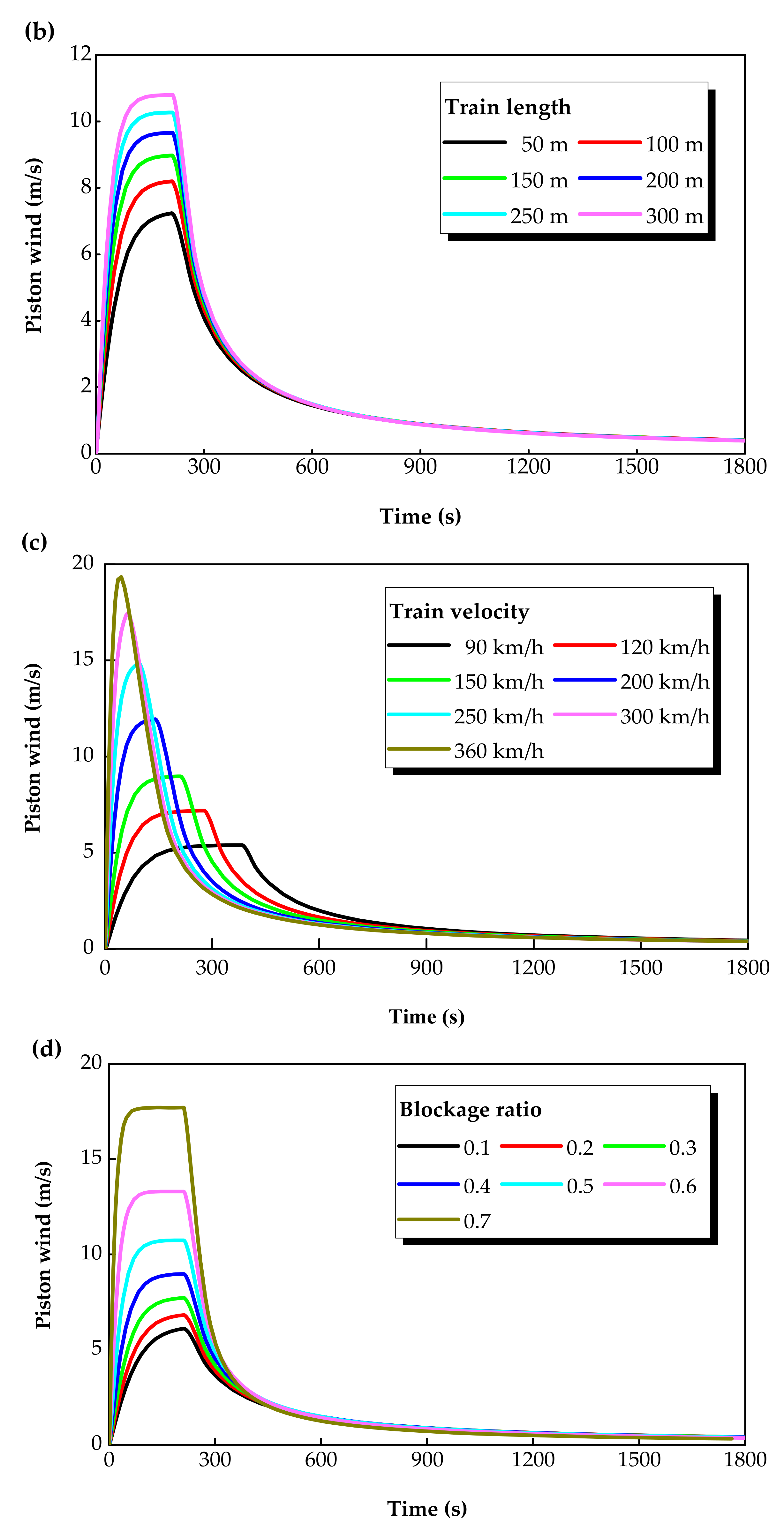
| Type | Symbol | Value | According to | Remarks |
|---|---|---|---|---|
| Length scale | 1/50 | Comprehensive factors | Consider indoor site and materials | |
| Velocity scale | 1/8.33 | Comprehensive factors | Consider the result error | |
| Area scale | 1/2500 | — | ||
| Flow quantity scale | 1/20,825 | — | ||
| Time scale | 1/6 | Strouhal similarity | ||
| Density scale | 1 | — | Same fluid (air), gas compression is ignored | |
| Viscosity scale | 1 | — |
| Initial Train Velocity (m/s) | Duration (s) | |||
|---|---|---|---|---|
| Entering Tunnel | Uniform Motion | Uniformly Decelerated Motion | Stationary | |
| 3 | 2 | 7.7 | 6 | 65 |
| 4 | 1.5 | 4 | 8 | 60 |
| Calculation parameter | L (m) | AT (m2) | D (m) | λ | λ0 | ζ1 | ζ2 | L0 (m) | v0 (m/s) | a (m/s2) | |
|---|---|---|---|---|---|---|---|---|---|---|---|
| Value | 3250 | 43.74 | 7.23 | 0.2835 | 0.02 | 0.02 | 0.5 | 1.0 | 300 | 24.99/33.33 | 0.6944 |
| Case | Tunnel Length L (km) | Train Length L0 (m) | Train Velocity v0 (km/h) | Blockage Ratio β |
|---|---|---|---|---|
| 1 | 10 | 150 | 150 | 0.4 |
| 2 | 15 | 150 | 150 | 0.4 |
| 3 | 20 | 150 | 150 | 0.4 |
| 4 | 25 | 150 | 150 | 0.4 |
| 5 | 30 | 150 | 150 | 0.4 |
| 6 | 35 | 150 | 150 | 0.4 |
| 7 | 20 | 50 | 150 | 0.4 |
| 8 | 20 | 100 | 150 | 0.4 |
| 9 | 20 | 150 | 150 | 0.4 |
| 10 | 20 | 200 | 150 | 0.4 |
| 11 | 20 | 250 | 150 | 0.4 |
| 12 | 20 | 300 | 150 | 0.4 |
| 13 | 20 | 150 | 90 | 0.4 |
| 14 | 20 | 150 | 120 | 0.4 |
| 15 | 20 | 150 | 150 | 0.4 |
| 16 | 20 | 150 | 200 | 0.4 |
| 17 | 20 | 150 | 250 | 0.4 |
| 18 | 20 | 150 | 300 | 0.4 |
| 19 | 20 | 150 | 360 | 0.4 |
| 20 | 20 | 150 | 150 | 0.1 |
| 21 | 20 | 150 | 150 | 0.2 |
| 22 | 20 | 150 | 150 | 0.3 |
| 23 | 20 | 150 | 150 | 0.4 |
| 24 | 20 | 150 | 150 | 0.5 |
| 25 | 20 | 150 | 150 | 0.6 |
| 26 | 20 | 150 | 150 | 0.7 |
Publisher’s Note: MDPI stays neutral with regard to jurisdictional claims in published maps and institutional affiliations. |
© 2020 by the authors. Licensee MDPI, Basel, Switzerland. This article is an open access article distributed under the terms and conditions of the Creative Commons Attribution (CC BY) license (http://creativecommons.org/licenses/by/4.0/).
Share and Cite
Yan, X.; Tao, L.; Peng, J.; Zeng, Y.; Fang, Y.; Bai, Y. Behavior of Piston Wind Induced by Braking Train in a Tunnel. Energies 2020, 13, 6420. https://doi.org/10.3390/en13236420
Yan X, Tao L, Peng J, Zeng Y, Fang Y, Bai Y. Behavior of Piston Wind Induced by Braking Train in a Tunnel. Energies. 2020; 13(23):6420. https://doi.org/10.3390/en13236420
Chicago/Turabian StyleYan, Xiaonan, Liangliang Tao, Junqin Peng, Yanhua Zeng, Yong Fang, and Yun Bai. 2020. "Behavior of Piston Wind Induced by Braking Train in a Tunnel" Energies 13, no. 23: 6420. https://doi.org/10.3390/en13236420
APA StyleYan, X., Tao, L., Peng, J., Zeng, Y., Fang, Y., & Bai, Y. (2020). Behavior of Piston Wind Induced by Braking Train in a Tunnel. Energies, 13(23), 6420. https://doi.org/10.3390/en13236420






